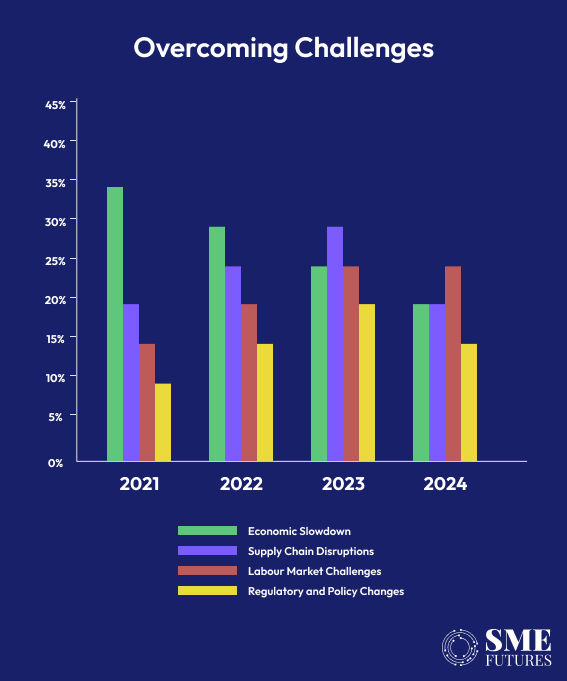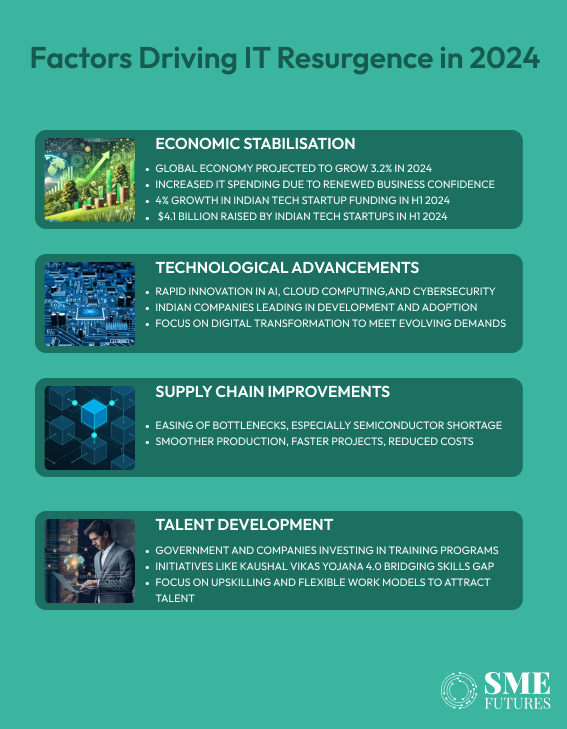The Indian IT industry, a cornerstone of the nation’s economic growth, has weathered a tumultuous storm over the past two years. The devastating storm of the COVID-19 pandemic, economic slowdowns, supply chain disruptions, talent shortages, and regulatory changes have tested the resilience of this vital sector. However, as the dust settles and the global economy begins to stabilise, a new dawn is breaking for the Indian IT industry. The year 2024 is poised to be a turning point, marking a resurgence of growth, innovation, and opportunity.
Overcoming challenges

The challenges faced by the Indian IT industry from 2021 to 2023 were multifaceted and interconnected. The pandemic-induced economic slowdown led to reduced IT spending, as businesses tightened their belts and prioritised essential operations. Supply chain disruptions, particularly the semiconductor shortage, hampered hardware production and delayed critical projects. The industry also grappled with a significant talent shortage, as the demand for skilled IT professionals outstripped the available supply.
“In the past two years, companies in the IT sector have navigated significant challenges through several strategic approaches,” says Prakhar Varshney, Founder and CEO of Huchstar.
“They swiftly adopted digital transformation, integrating advanced technologies like cloud computing, artificial intelligence, and automation to maintain productivity and ensure business continuity. The shift to remote work became essential, prompting investments in secure and efficient remote work infrastructure. Enhanced cybersecurity measures were also implemented to protect against the rising threat of cyberattacks,” he adds.
Moreover, IT companies prioritised employee well-being by introducing flexible work policies and providing support for mental health, which helped retain talent and sustain morale during those turbulent times. These comprehensive strategies not only allowed IT firms to adapt but also enabled them to thrive amidst global disruptions, showcasing their innovation in the face of unprecedented challenges.
Despite daunting challenges, the Indian IT sector demonstrated remarkable resilience. Companies adapted to remote work models, embraced digital transformation, and invested in upskilling their workforces. The government also played a crucial role, introducing stimulus packages and incentives to support the sector.
Winds of change: Factors driving the resurgence

Several key factors are converging to create a favourable environment for the resurgence of the Indian IT industry in 2024.
Economic Stabilisation: The global economy is showing signs of recovery, with a projected growth rate of 3.2% in 2024. This renewed confidence is translating into increased IT spending, as businesses invest in technology to drive efficiency and competitiveness. In India, the tech start-up ecosystem has already witnessed a 4% growth in funding in H1 2024 compared to H2 2023, signalling a positive trend. According to a report by Tracxn, the total funding raised by Indian tech start-ups in H1 2024 was $4.1 billion.
“The stabilising economy is a welcome relief for the IT sector,” remarks Giridhar LV, CEO & Co-founder of Nuvepro, adding, “It’s providing the much-needed impetus for businesses to resume their IT investments and drive innovation.”
Technological Advancements: The rapid pace of technological innovation is opening up new frontiers for the Indian IT industry. Artificial intelligence (AI), cloud computing, and cybersecurity are emerging as key growth drivers. Indian companies are at the forefront of developing and adopting these technologies, creating innovative solutions for both domestic and global markets.
“In 2024, the Indian IT sector is experiencing a significant resurgence, with a strong focus on digital transformation. To meet the evolving demands of businesses and consumers, particularly in e-commerce, digital payments, and online entertainment, IT companies in India are adapting their strategies,” Varshney contends.
Supply Chain Improvements: The easing of supply chain bottlenecks, particularly the semiconductor shortage, is a significant boon for the Indian IT industry. This is enabling smoother production schedules, faster project completions, and reduced costs.
Talent Development: The Indian Government and IT companies are investing heavily in training and development programmes to bridge the skills gap. Initiatives like the Kaushal Vikas Yojana 4.0 are equipping the youth with industry-relevant skills, creating a pipeline of talent for the future.
“Demand for talent continues to outpace the availability of suitable candidates. Acquiring and retaining skilled talent remains a critical challenge for businesses and talent acquisition agencies. Businesses are addressing this by investing heavily in training and upskilling programmes,” says Pramod Sharda, CEO, IceWarp – India and Middle East.
“Either this is done in-house or by collaborating with educational institutions that can provide a certification which will find recognition in the market as well. Adopting flexible work models is also the need of the hour as this aspect is also a deciding factor while attracting top talent,” he adds.
A bright future beckons
The resurgence of the Indian IT industry is not just a rebound; it’s a transformation. The sector is emerging from the pandemic stronger, more agile, and more innovative. The convergence of favourable economic conditions, technological advancements, supply chain improvements, and talent development initiatives is creating a fertile ground for growth. According to a report by Tracxn, 3 new unicorns were created in H1 2024, compared to none in H1 2023.
“The Indian IT sector in 2024 marks a transformative year for the IT sector. With a renewed focus on digital transformation and the strategic adoption of emerging technologies like AI, cloud computing, and cybersecurity, businesses are poised to achieve unprecedented growth. However, this journey requires a collective effort to address talent shortages, ensure ethical technology use, and build robust supply chains,” says Giridhar.
“Hands-on upskilling and reskilling solutions ensure that businesses are not only prepared to meet the current demands but are also equipped to navigate future challenges. By fostering a culture of continuous learning and collaboration, companies are empowering professionals with the skills they need to thrive in this dynamic landscape, driving the sector forward with confidence and responsibility,” he adds.
The road ahead is not without its challenges. The industry will need to continue to adapt to the evolving global landscape, address cybersecurity threats, and navigate regulatory changes. However, the future looks bright. With its strong foundation, talented workforce, and supportive government policies, the Indian IT industry is well-positioned to reclaim its position as a global leader in technology and innovation.
Opportunities abound
The resurgence of the Indian IT industry presents a plethora of opportunities for investors. The sector is ripe for investment, with a wide range of promising start-ups and established companies driving innovation across various domains.
From e-commerce and fintech to healthcare and education, the Indian IT industry is making significant strides in transforming various sectors. The government’s push for digital inclusion and the increasing adoption of technology by businesses and consumers are creating a vast market for IT products and services.
The Indian IT industry is on the cusp of a new era. The challenges of the past have served as a catalyst for change, driving the sector to become more resilient, adaptable, and innovative. As the global economy recovers and technology continues to evolve at a breakneck pace, the Indian IT industry is ready to seize the opportunities that lie ahead and solidify its position as a global leader in technology and innovation.











